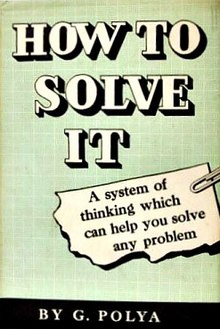
How to solve it
GEORGE POLYA’s lovely book How to Solve It, is not just about mathematics but about problem solving in a wider sense.
xvi Guidelines are not literal
p1 A teacher should help the students, share knowledge, and swap places
p15 — A problem is never exhausted // Drop the idea that problems have little or no relation to each other
p72 Try to prove formally what is seen intuitively and to see intuitively what has been proved formally
p75-6 decomposing and recombining problems… variations on the problem…
p77 more and more remote details… (Two questions may be better than one // breaking the question down into a simpler form and working on this first // assuming part of the tricky question is already answered and then working on the other part)
p105 diagram ‘as done’…
p132 You must guess, but also examine your guess // (p181 plausible reasoning)
p134 A good notation should be unambiguous, pregnant, easy to remember, it should avoid harmful second meanings and take advantage of useful second meanings; the order and connection of signs should suggest the order and connection of things.
p197 Present abstract ideas concretely.
p198 (On subconscious work:) There is a limit beyond which we should not force the conscious reflection, when it is better to leave this problem alone for a while. But it is desirable not to set aside a problem to which we wish to come back later without the impression of some achievement; at least some little point should be settled, some aspect of the question somewhat elucidated when we quit working. Only such problems come back improved whose solution we passionately desire, or for which we have worked with great tension. Conscious effort and tension seem to be necessary to set the unconscious work going
p205 The importance of looking back over the solution (seeing what other information is hidden in the answer; seeing other ways one could have proved the solution, seeing new areas of possible application of the solution, etc)
p206 The need for models for the student to aspire to, for proper teachers, for good quality texts, and for competition with capable friends
p207 The open secret of real success is to throw your whole personality into your problem
p210 When stuck, set a new question // a new question unfolds untried possibilities of contact with our store of previous knowledge
p227 Working backwards from the answer one is trying to prove.
— Teaching to solve problems is education of the will. Solving problems which are not too easy for him, the student learns to persevere through unsuccess, to appreciate small advances, to wait for the essential idea, to concentrate with all his might when it appears. If the student had no opportunities in school to familiarise himself with the varying emotions of the struggle for the solution then his mathematical education failed in the most vital point.
